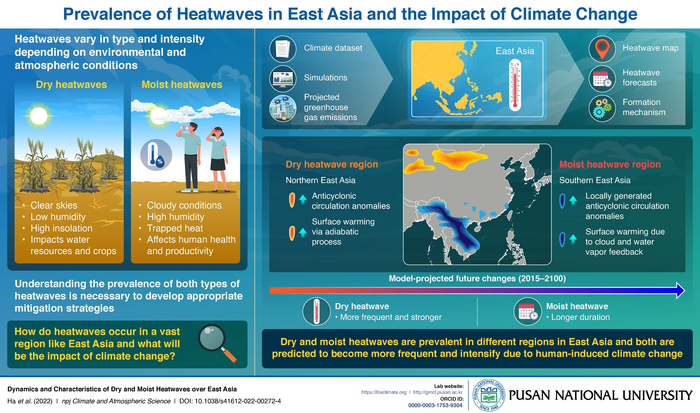Described as periods of excessively high temperatures, heatwaves have a devastating impact on human life, agriculture, and water resources. Weather and atmospheric conditions can lead to two types of heatwaves: dry heatwaves occur when the skies are clear, exposing the area to large amounts of solar radiation, while moist heatwaves occur when water vapor traps heat due to cloudy, humid conditions. Owing to the effects of global warming, these events have grown more intense and frequent in recent years. With climate simulations predicting heatwaves to be more frequent and intensify with increasing greenhouse gas emissions, it becomes important to map out vulnerable regions so that adequate plans can be made to deal with them in the future.

Credit: Pusan National University
Described as periods of excessively high temperatures, heatwaves have a devastating impact on human life, agriculture, and water resources. Weather and atmospheric conditions can lead to two types of heatwaves: dry heatwaves occur when the skies are clear, exposing the area to large amounts of solar radiation, while moist heatwaves occur when water vapor traps heat due to cloudy, humid conditions. Owing to the effects of global warming, these events have grown more intense and frequent in recent years. With climate simulations predicting heatwaves to be more frequent and intensify with increasing greenhouse gas emissions, it becomes important to map out vulnerable regions so that adequate plans can be made to deal with them in the future.
Now, in a study published in npj climate and atmospheric science, a team of international researchers led by Professor Kyung-Ja Ha from Pusan National University, South Korea, have analyzed the prevalence of the two types of heatwaves in East Asia. Using historical climate data, they determined for the first time how and where these heatwaves form and also predicted the occurrence of heatwaves in the future under different greenhouse gas emission scenarios.
According to their study, dry heatwaves occur mainly in northwestern East Asia, while moist heatwaves are prevalent over southern East Asia. These heatwaves were observed to have intensified in duration and frequency over the past 60 years (1958–2019). The research team found that these heatwaves tend to be frequent under favorable large-scale atmospheric conditions, which vary for dry and moist heatwaves. “In dry heatwave regions, anticyclonic, that is clockwise circulation, is amplified after the onset of heatwaves under the influence of the convergence of anomalous wave activity flux over northern East Asia. This results in surface warming via adiabatic processes. In contrast, the moist heatwaves are triggered by the locally generated anticyclonic circulation anomalies, and surface warming in these cases is amplified by cloud and water vapor feedback,” explains Prof. Ha.
The researchers then went on to analyze how increases in greenhouse gas emissions would affect heatwaves. The simulations revealed more frequent dry heatwaves and longer-lasting moist heatwaves even when greenhouse gas emissions were kept to a minimum to limit the temperature rise to 1.5°C, suggesting the need for further reductions in greenhouse gas emissions to avoid severe heatwave conditions.
Studying heatwaves by their types is essential as these events form under different conditions and lead to different outcomes. “Increases in dry heatwaves are expected to damage agriculture, while moist heatwaves can be extremely detrimental to the human body,” cautions Prof. Ha. Identifying vulnerable regions can assist governing bodies in developing strategies that will mitigate the impacts of severe heatwaves. This involves planning for increased electricity use in places at risk of experiencing moist heatwaves and managing water supplies in regions susceptible to dry heatwaves.
***
Reference
Authors: Kyung-Ja Ha 1,2, Ye-Won Seo 1,3, Ji-Hye Yeo 1,2, Axel Timmermann 1,3, Eui-Seok Chung 4*, Christian L. E. Franzke 1,3, Johnny C. L. Chan 5, Sang-Wook Yeh 6 and Mingfang Ting 7
DOI: https://doi.org/10.1038/s41612-022-00272-4
Affiliations:
1 Center for Climate Physics, Institute for Basic Science, Busan, South Korea
2 Department of Atmospheric Sciences, Pusan National University, Busan, South Korea
3 Pusan National University, Busan, South Korea
4 Korea Polar Research Institute, South Korea
5 City University of Hong Kong, China
6 Hanyang University, South Korea
7 Columbia University, USA
Lab Page: https://ibsclimate.org , http://gmcl.pusan.ac.kr
ORCID ID (Kyung-Ja Ha): https://orcid.org/0000-0003-1753-9304
About Pusan National University
Pusan National University, located in Busan, South Korea, was founded in 1946, and is now the no. 1 national university of South Korea in research and educational competency. The multi-campus university also has other smaller campuses in Yangsan, Miryang, and Ami. The university prides itself on the principles of truth, freedom, and service, and has approximately 30,000 students, 1200 professors, and 750 faculty members. The university is composed of 14 colleges (schools) and one independent division, with 103 departments in all.
Website: https://www.pusan.ac.kr/eng/Main.do
About the authors
Prof. Kyung-Ja Ha, an expert in the climatic extreme and monsoon hydrology at Pusan National University. She joined the department of atmospheric sciences as a faculty member in 1994. Her research group has been leading the research on monsoon dynamics, climate physics, and boundary layer physics. She has also been working at the IBS Center for Climate Physics (ICCP) with Prof. Axel Timmermann (director of ICCP) from 2017 as affiliated professor.
She has coauthored this article with co-corresponding authors, Dr. Ye-Won Seo (ICCP) and Dr. Eui-Seok Chung (KOPRI) who are experts in climate physics and dynamics, developing mechanisms for extremes such as heatwaves, droughts, and compound climatic hazards.
ICCP’s Ji-Hye Yeo, Axel Timmermann, Christian Franzke (ICCP), Johnny Chan (City University of Hong Kong), Sang-Wook Yeh (Hanyang University), and Mingfang Ting (Lamont-Doherty Earth Observatory, Columbia University) are also co-authors of this study.
Journal
npj Climate and Atmospheric Science
DOI
10.1038/s41612-022-00272-4
Method of Research
Computational simulation/modeling
Subject of Research
Not applicable
Article Title
Dynamics and characteristics of dry and moist heatwaves over East Asia
Article Publication Date
21-Jun-2022




